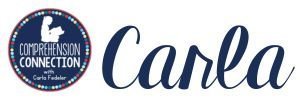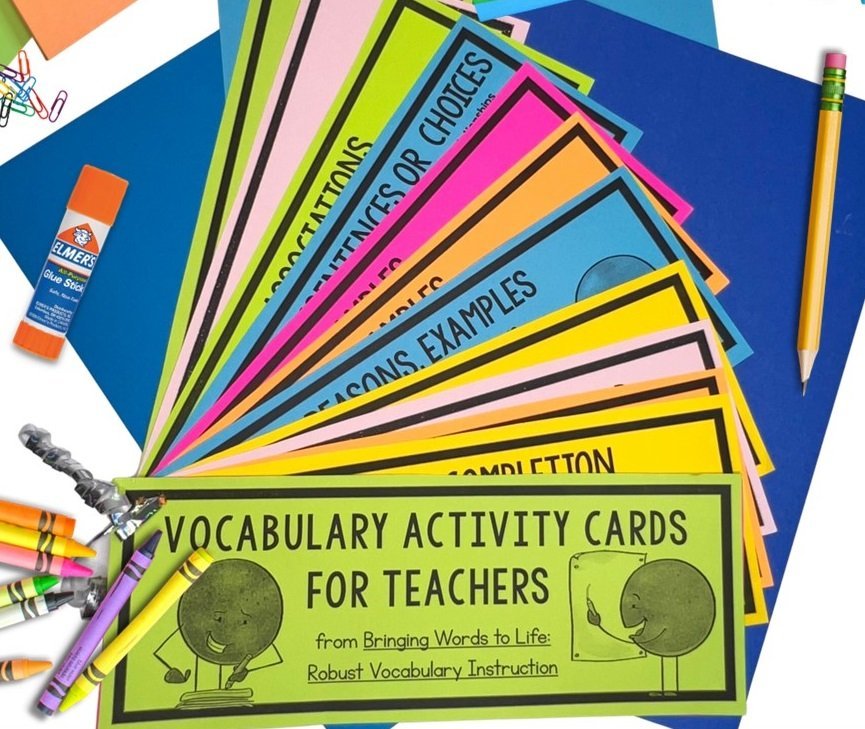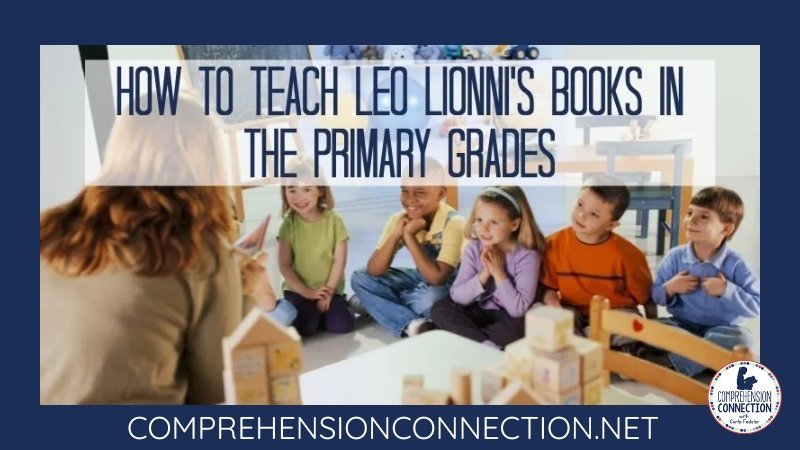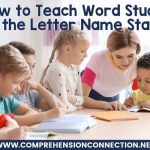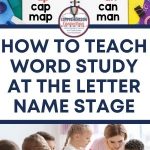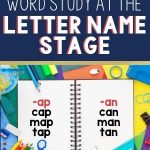
What traits do you see in letter name stage? Is inventive spelling your norm? Are your students between age 5 and 8? Are you beginning the school year with short vowel sounds? If the answer to these questions are yes, then chances are you are teaching letter name spellers. Why is it called “Letter Name” you may wonder? Well, at this stage of learning, the child writes the letter name that they hear. In this post, I’ll share with you the feature sequence and teaching tips.
What Letter Name Spellers Know and Need to Learn
The focus of the Letter Name Stage is on single syllable short vowel words that follow the CVC pattern, and throughout this stage, letter name spellers are learning short vowels, blends, consonant digraphs, and nasal sounds. Letter name spellers have developed a concept of word and recognize a small number of sight words. The way they figure out spelling of unfamiliar words is to match the salient sounds of a word with the letter that has the same sound or the closest approximation of the sound (BAF might be used for brave. JN would be written for chin, and JRIV might be used for drive). Short vowels are substituted by sounds that are articulated in the same part of the mouth. Examples of this would be NAT for net, PEG for pig, BOP for bump. Blends and digraphs are often incomplete such as HEN for chin and BAV for brave. Preconsonantal nasals are omitted, but develop at the end of the Letter Name Stage.
Activities that work well for Letter Name Spellers
Students should, of course, be doing lots of writing with their invented spellings, and student writing is a great way to see and measure student progress. There is no better practice for learning letter sound correspondences. As a daily routine, teachers should use shared writing for modeling the letter/sound relationship. Include opportunities for informal writing practice such as post cards, letters to friends, drawing and labeling, making lists, and journaling.
Reading also provides students with the opportunity to practice what they are learning about letters and sounds. Do not expect students to “sound out” entire words, but do encourage them to use, at least, the initial consonant sound and the context to attempt the decoding of new words. As you read together, use this opportunity for word hunts, writing sorts, finding rhyming words, and pointing out word families. Word study is about decoding as much as it is on spelling. Students apply phonics clues based upon their spelling stage by “Getting Their Mouths Ready” and “Finding Sound Chunks”.
Word Building Toolkit
For this stage, making words is a great way to practice using the sounds you’re focusing on. This resource is one I use ALL..THE…TIME. It includes printable cards that you can print on colored paper to help your students recognize the onset/rime of words and model how sounds come together to make both real and nonsense words. I also use it for making and reading nonsense words. This activity is a great way to practice applying CVC rules and to see whether your student truly understands the sounds each letter makes.
Words Their Way Spelling Sorts
Of course, the main teaching strategy for word study is the sort. Many teachers have Words Their Way, but remember that it’s not intended to be used from sort 1 to sort 30 week by week. Many students need more than one week to master a pattern, and you may find that the words in a particular sort are known as sight words verses by pattern. For this reason, I’d recommend having a sort template that you can use to adjust the lists you choose when needed. Base the list upon your students’ performance on the screenings you do quarterly as well as performance in writing, on written sorts by pattern, on your observations with running records, and on assessments you give.
In addition to the activities above, traditional spelling practice activities are fine with some being better than others. Keep the focus on patterns and sounds. Games that practice consonant digraphs with reading/writing words or center activities that have students making words with consonant blends are great, but writing words three times each? Well, maybe not as motivating or useful.
Teaching Letter Name Features
As you dig into using word study, there is a recommended order to how you teach the features. You can think of it as a developmental progression. When you assess your students, watch for what the child knows, uses but confuses, and isn’t ready for. By doing this, you see which features are mastered. Begin at the point where the child has confusion first. Here are the five features and suggestions on how to work with them.
BEGINNING LETTER NAME STAGE
At the beginning of the letter name stage, most students are in kindergarten. They’ve learned a collection of letter names and sound, and they’re using the most salient sound in their writing. At this stage, using picture sorts works very well for helping solidify the sounds/symbol connection. Challenges for students at the beginning are the letters G and J, S and C, N and M, Y and W, F and V, and P, D, and B. As you work on picture sorts for beginning sounds, using a consistent key word to attach to the letter helps students remember the sound.
In addition to beginning sounds, teachers will also work on ending sounds in this feature. Again, use picture cards to help students connect the sounds they produce to the symbol they’re sorting for. When choosing the ending sounds, try to select sounds that are contrasting versus similar. For example, t and d are often difficult for children to distinguish whereas s and t would be more easily done. Phrases I find helpful in teaching students to “hear” sounds are “Feel what your mouth is forming” and “Stretch out your word.” These seem to help the student make the connection.
MASTERING SHORT VOWELS at the letter name stage
When you are working with initial consonants, using word families helps the student get a preview at the families that are coming. We begin with short a words with common endings such as MAN, CAN, FAN, and TAN. Why is this? Well, it puts the focus on the initial consonant, right? Then, we change the ending consonant with the same vowel sound by comparing words like MAN, FAN, and PAN with MAT, FAT, and PAT. Later, when you compare families such at HOT, COT, and POT and HAT, CAT, and PAT, your attention shifts to the short vowel sound.
As you work on short vowels, focus on comparing those produced in different parts of the mouth. Vowels that students confuse are e/a and e/i because they are produced in a very close part of the mouth. Instead, contrast a/i/o or o/e. Below is a possible sequence of word family study.
- AT family – match words to pictures
- AN family – match words to pictures
- AT and AN – compare by sorting into families
- AT, AG, AP- sort pictures and words
- AN, AD, ACK – continue as above
- OG and OT
- OG, OT, OP, OCK
- AT and OT (compare vowel sounds at this point)
- ACK and OCK
- AG, OG, AP, OP
- ILL, IG, IP
- IP, AP, OP
- EN, ET
- UT, UN, UG
- AT, ET, IT, UT, OT
- AG, OG, IG, UG, EG
Using Nonsense Words with letter name lessons
Remember that the GOAL is for students to apply what they’ve learned to their reading too. Students begin to generalize the ability to “chunk” the vowel and what follows in other words over time. This even carries over into multisyllabic words. My friend, Emily from Curious Firsties made THIS FREEBIE. I have used it quite a bit with my tutoring students this summer. Working with nonsense words and applying the chunks to 2 syllable words helps my students build automaticity in their reading.
MOVING ON WITH BLENDS AND DIGRAPHS
At first, you’ll work on initial digraphs (CH, SH, and TH) by comparing them to the single consonant sounds that the students may be using (compare S and SH, C, J, H and CH, T and TH). A lot of the time, students don’t see the h or recognize that a new sound is formed. ELL students will often substitute sh/ch, so be on the watch for this. It is common in the way the sounds are formed. When teaching WH, be careful to not compare it to W because in most WH words, the sound is challenging to distinguish. Instead, compare to sh, ch, or th.
Use caution in terminology and remember these teaching points. Consonant digraphs make one sound. Consonant blends preserve the sound of each letter. Another interesting teaching point is that WH ONLY comes at the beginning of words, and ck is only found at the end with a short vowel. Here is a possible sequence teachers can use:
- SH, S, H
- CH, S, H, J
- CH, SH, TH, WH
- ST, S, T
- SP, SP, P
- ST, SP, SK, SM
- SL, SN, SC, SW
- CL, C, L
- CL, PL, BL, GL
- BL, BR, GL, GR
- CL, CR, FL, FR
- GR, TR, DR, PR
- WH, QU, TW, K
Blends come quickly for many children and this progression should be abbreviated unless it is needed. Kids who have had speech related challenges and ear infections will have difficulty “hearing” the second consonant in blends.
WHAT IS AN AFFRICATE? (letter name FEATURE 4)
Affricates refer to the speech sound heard at the beginning of job or chop when they are pronounced. Several letters and combinations of letters besides j and ch also produce this sound in English. For example, the g in gym, and the blends tr and dr in tree and trot feel the same when you produce the sound. (Say them to yourself to fully understand, but make sure you are in a private setting. LOL!). Common formations of these sounds include g, j, dr, tr, and ch.
- dr, d, j, hard g
- ch, tr, t
- ch, dr, tr, j
PRECONSONANTAL NASALS-letter name feature 5
The focus for this last feature is on the word family or rime part of the word. Teaching them in this way helps your kids better recognize the chunks of sound in other longer words. When beginning with rimes, you can have students examine ash, ish, ush, and then collapse then into the final element /sh/, as was done with short vowels. Rimes with final ck (ick, ock, uck) are also introduced during this feature; but also reviewed in the Within Word Pattern Stage when they’re compared to long vowel patterns.
Ending digraphs
- –ch -th -sh
- -ng -sh
- -ft
- -lf -lk -lp -lt
- -mp
- –nd
- –nk
- –nt
What about the Homework Routine for letter name spellers?
For the letter name speller, reading, sorting, and writing the sort are the most beneficial forms of practice, but the key is to help your students see and hear the difference between vowels in particular. Contrasting the sounds is the best way for kids to hear the difference and feel it when they produce the sounds. Students will read the words and recognize the patterns before they’ll be able to apply it in their writing, but they must be able to write it. NOTE-Your parents will not be familiar with this approach, so be sure to explain in detail how it works in order to alleviate stress at homework time. Here is a homework frame I’ve used.
- Day 1-Cut apart the sort and practice reading/sorting with your parents. Write the sort once comfortable. Place words in baggy.
- Day 2-Practice reading and sorting your words 2 times. On the third sort, time yourself.
- Day 3-Student choice…write your words with sidewalk chalk, in shaving cream, with colored pencils, or someway fun. Complete a no-peek sort with your parents after you’ve practiced.
- Day 4-Glue the sort onto notebook paper
- Day 5-Test if ready. (Note…I stagger introduction days to avoid Friday test days)
letter name Word Study Progress Monitoring
One question you may be wondering about is progress monitoring. With my groups, I try to do quarterly screenings to see how my students are doing. It helps me know whether I need to adjust my groups. Remember to have no more than 3 (or 4 groups if you have a larger class size or wide level range).
Because kids learn at different rates and acquire knowledge through reading and writing, you may find that kids grasp a pattern on their own, so watch that you aren’t locking them into a track. Groups need to remain fluid and match as closely as possible the needs of the student.

Word Study Resources You Might Find Helpful
This product is hot off the presses! It includes everything you need for this stage including:
- 60 pages of sorts by feature
- 10 pages of beginning sound picture cards
- 23 pages of activities and games
- 12 monthly word study choice menus for literacy stations
- and progress monitoring forms.
Do you have other questions? Please ask. I will email you directly if able or reply to you here. You could also send me a message through Facebook if you have a specific question.
Links to Other Stages:
- Getting Started with Word Study: Explains how to get started with assessment and grouping.
- Emergent Reader: Shares how kindergarten teachers can use the sorting process with concept sorts, font sort, and picture sorts to build understanding.
- Letter Name Speller: This post includes the letter name features, teaching ideas, and look fors.
- Within Word Speller: Students at this stage are working on long vowel words, r contolled words, and words with complex consonants. The post includes the features included, activity ideas, and other relevant points.
- Syllable Juncture Speller: The students at this stage are building fluency and are writing extended amounts. Check out this post if your students are confused with the spelling of multi syllabic words.
- Derivational Relations Teaching Ideas: At this level, students are working to grow vocabulary. Students at this stage are typically in fifth grade and up.











